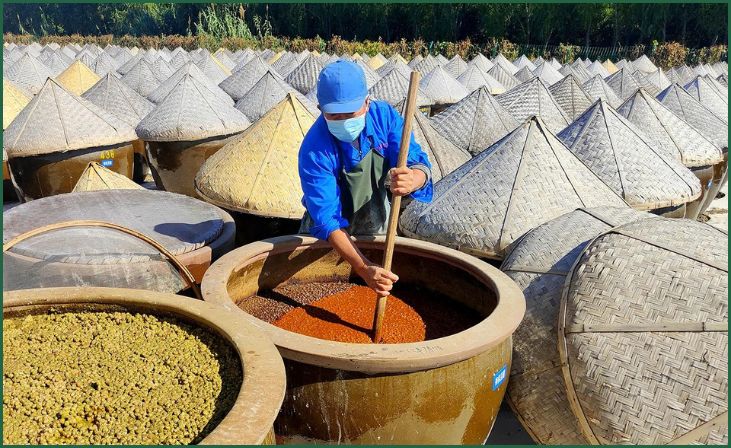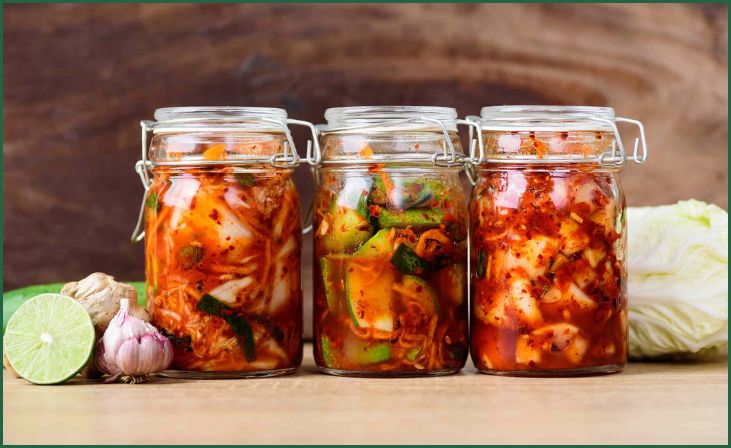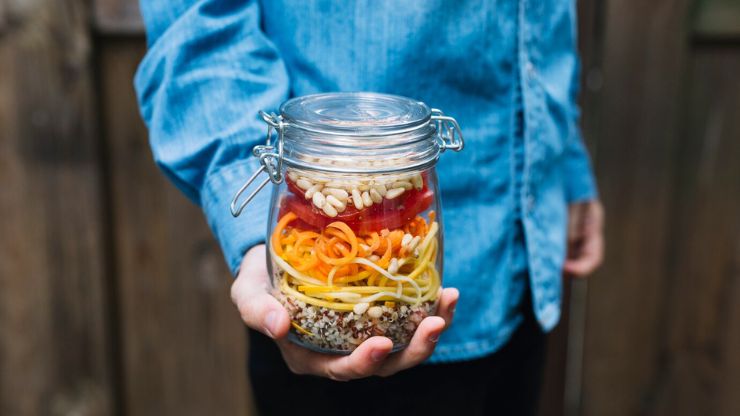Foods You Didn’t Know Were Fermented – Have you ever wondered about the secrets hiding in plain sight on your plate? Unraveling the intriguing world of culinary surprises, we bring you an exploration of six unsuspecting foods that undergo the transformative magic of fermentation. From the tangy depths of kimchi to the probiotic richness of kefir, these stealthily fermented delights might just revolutionize your understanding of everyday gastronomy.
Table of Contents
Toggle6 Foods You Didn’t Know Were Fermented
1. Yogurt

Frequently enjoyed as a healthy breakfast or a creamy snack, yogurt is a beloved dairy product that undergoes a fascinating fermentation process. The transformation begins with the introduction of lactic acid bacteria, such as Lactobacillus bulgaricus and Streptococcus thermophilus, into milk. These bacteria break down the lactose, the natural sugar in milk, converting it into lactic acid.
This process makes the milk thicker and gives yogurt its sour taste. Beyond its delectable taste, yogurt is renowned for its probiotic properties, promoting gut health and boosting the immune system. Rich in calcium, protein, and essential vitamins, yogurt stands as a versatile and nourishing fermented delight. This is the first food on our list of 6 Foods You Didn’t Know Were Fermented.
Also Read: Stages of Fermentation
2. Kimchi
Hailing from Korea, kimchi is a staple side dish that embodies the art of fermentation. Typically made from fermented vegetables, such as napa cabbage and radishes, and seasoned with a blend of garlic, ginger, and chili pepper, kimchi boasts a complex flavor profile that is both spicy and tangy. The fermentation process involves submerging the ingredients in a brine solution, allowing lactic acid bacteria to work their magic.
This not only gives kimchi its signature piquancy but also results in a dish teeming with beneficial bacteria, vitamins, and antioxidants. Its diverse culinary applications, from accompanying rice dishes to being a key ingredient in soups and stews, have solidified kimchi’s place in both Korean cuisine and the global culinary landscape. This is the second food on our list of 6 Foods You Didn’t Know Were Fermented.
3. Kombucha

Serving as a refreshing and trendy probiotic beverage, kombucha is a fermented tea that has gained immense popularity in recent years. This effervescent elixir begins with a base of sweetened black or green tea, to which a symbiotic culture of bacteria and yeast, known as a SCOBY, is added.
The SCOBY initiates the fermentation process, converting the sugar into organic acids and carbonation. This results in a lightly sweet and tangy beverage with a slight fizz, offering a delightful alternative to sugary sodas. Beyond its fizzy appeal, kombucha is revered for its potential health benefits, including improved digestion, immune support, and detoxification. This is the third food on our list of 6 Foods You Didn’t Know Were Fermented.
4. Sauerkraut
Originating from Germany, sauerkraut is a traditional fermented dish made from finely cut cabbage that has been fermented by lactic acid bacteria. This sour yet savory delicacy boasts a rich history, with its origins dating back to ancient times when fermentation was a crucial method of food preservation.
The fermentation process not only gives sauerkraut its distinctive tang but also enhances its nutrient content. Packed with vitamins C and K, as well as various antioxidants and fiber, sauerkraut stands as a versatile and healthy addition to a variety of dishes, from hot dogs and sandwiches to hearty stews and salads. This is the fourth food on our list of 6 Foods You Didn’t Know Were Fermented.
5. Soy Sauce

A cornerstone of Asian cuisine, soy sauce is a flavor-enhancing condiment that owes its complex taste to the fermentation of soybeans. This umami-rich sauce is produced by fermenting a mixture of soybeans, roasted grains, brine, and a specific mold called Aspergillus oryzae.
Over the fermentation period, the enzymes produced break down the proteins and carbohydrates, resulting in a liquid that is then pressed, pasteurized, and bottled. The fermentation process grants soy sauce its distinct salty, earthy, and slightly sweet flavor, making it a versatile seasoning for a wide array of dishes, including stir-fries, marinades, and dipping sauces. This is the fifth food on our list of 6 Foods You Didn’t Know Were Fermented.
Don't just scroll, subscribe!
BuzzTrail's unique web-stories are the cure for boredom you've been waiting for.
Also Read: How Does Lacto Fermentation Work
6. Pickles
A beloved addition to sandwiches and snacks, pickles are cucumbers that have undergone a transformative fermentation process. By immersing cucumbers in a brine solution containing salt, water, and various flavor-enhancing spices, the naturally present lactic acid bacteria kick-start the fermentation process.
This results in the characteristic sour and crunchy pickle, bursting with a delightful blend of tanginess and spices. Beyond their zesty flavor, pickles offer a host of health benefits, including improved digestion, hydration, and the provision of essential vitamins and minerals. Whether relished on their own or added to salads and sandwiches, pickles serve as a delectable and wholesome fermented treat. This is the sixth food on our list of 6 Foods You Didn’t Know Were Fermented.
5 Tips To Store Fermented Foods

Storing fermented foods properly is essential to maintain their flavor, texture, and nutritional value. Here are five tips to ensure the effective storage of fermented foods:
Refrigeration
Most fermented foods, once they have reached the desired level of fermentation, should be stored in the refrigerator to slow down the fermentation process. This helps to preserve their taste and texture while also ensuring they remain safe for consumption. Keep fermented foods in airtight containers or jars to prevent exposure to air, which can lead to spoilage.
Fermentation Vessels
If you’re fermenting foods at home, ensure you use proper fermentation vessels, such as glass jars or ceramic crocks with airtight lids. These containers should be clean and sanitized before use. Choose vessels that allow for easy removal of excess air and create an optimal environment for the fermentation process.
Temperature Control
Maintain a consistent temperature for storing fermented foods. A cool and stable environment is ideal, as fluctuations in temperature can affect the fermentation process and lead to spoilage. Avoid placing fermented foods in areas that are prone to temperature changes, such as near stoves or windows, as these fluctuations can promote the growth of harmful bacteria.
Labeling and Date
Properly label your fermented foods with the date of preparation. This practice helps you keep track of the fermentation duration and ensures that you consume the foods within the recommended time frame. Use labels that are easily legible and waterproof to prevent them from smudging or fading over time.
Hygiene and Cross-Contamination
Maintain proper hygiene when handling fermented foods to prevent cross-contamination. Use clean utensils and hands when serving or transferring fermented foods to new containers. Ensure that the containers and storage area are regularly cleaned and sanitized to prevent the growth of harmful bacteria, mold, or yeast.
By following these tips, you can extend the shelf life of your fermented foods and preserve their quality, ensuring that you can enjoy their unique flavors and health benefits for an extended period.
Also Read: Teaching Children about Fermentation
Conclusion
As we delve deeper into the nuances of food fermentation, a whole new world of tastes and textures unfolds before us. From the humble origins of fermented soybeans to the complex elegance of sauerkraut, these six undercover fermented foods offer a delightful blend of tradition, health, and culinary finesse. Embrace the tang, relish the probiotics, and embark on a journey of gastronomic discovery that transcends the ordinary.
FAQs
What does fermenting mean when it comes to making food?
What does fermenting mean when it comes to making food?
Fermentation isn’t just a process; it’s a culinary alchemy that enhances both the taste and nutritional value of various foods. It not only enriches the flavor profile but also boosts the food’s probiotic content, promoting gut health and aiding digestion.
Are fermented foods safe for consumption?
Are fermented foods safe for consumption?
When prepared in controlled environments, fermented foods are not only safe but also beneficial for overall health. However, it’s crucial to follow proper fermentation techniques to prevent harmful bacterial growth. Always ensure that you source fermented foods from reliable, hygienic sources to minimize any potential risks.

